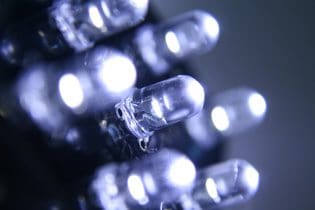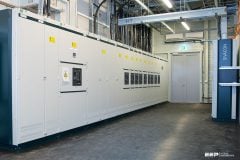 A Light Emitting Diode (LED) is a semiconductor device which converts electricity into light. Each diode is about 1/4 inch in diameter and uses about ten milliamps to operate at about a tenth of a watt. LEDs are small in size, but can be grouped together for higher intensity applications.
A Light Emitting Diode (LED) is a semiconductor device which converts electricity into light. Each diode is about 1/4 inch in diameter and uses about ten milliamps to operate at about a tenth of a watt. LEDs are small in size, but can be grouped together for higher intensity applications.
LED fixtures require a driver which is analogous to the ballast in fluorescent fixtures. The drivers are typically built into the fixture (like fluorescent ballasts) or they are a plug transformer for portable (plug‐in) fixtures. The plug‐in transformers allow the fixture to run on standard 120 volt alternating current (AC), with a modest (about 15 to 20 percent) power loss.
The efficacy of a typical residential application LED is approximately 20 lumens per watt (LPW). Incandescent bulbs have an efficacy of about 15 LPW and compact fluorescents (Energy saver Bulbs) are about 60 LPW, depending on the wattage and lamp type. LEDs are better at placing light in a single direction than incandescent or fluorescent bulbs.
Because of their directional output, they have unique design features that can be exploited by clever designs. LED strip lights can be installed under counters, in hallways, and in staircases; concentrated arrays can be used for room lighting.
Waterproof, outdoor fixtures are also available. Some manufacturers consider applications such as gardens, walkways, and decorative fixtures outside garage doors to be the most cost‐efficient. LED lights are more rugged and damage‐resistant than compact fluorescents and incandescent bulbs. LED lights don’t flicker.
They are very heat sensitive; excessive heat or inappropriate applications dramatically reduce both light output and lifetime. Uses include:
- Task and reading lamps
- Linear strip lighting (under kitchen cabinets)
- Recessed lighting/ceiling cans
- Porch/outdoor/landscaping lighting
- Art lighting
- Architectural lighting
- Night lights
- Stair and walkway lighting
- Pendants and overhead
- Retrofit bulbs for lamps
Attributes
Individual LEDs are considerably more efficient; however, the lamp or fixture design is reduced by the driver and electronics. In addition, LEDs do not produce heat like incandescent bulbs.
LEDs last considerably longer than incandescent or fluorescent lighting. LEDs don’t typically burn out like traditional lighting, but rather gradually decrease in light output. Their “useful life” is defined by the Alliance for Solid‐State Illumination Systems and Technologies (ASSIST) as the time it takes until 70% of initial light output is reached, often 50,000 hours.
They are resistant to thermal and vibrational shocks and perform well when subjected to frequent on‐off cycling.
| Light Source | Range of Typical Rated life (hours)* (varies by specific lamp type) | Estimated Usefull Life (L70) |
| Incandescent | 750 – 2000 | |
| Halogen incandescent | 3000 – 4000 | |
| Compact fluoroscent (CFL) | 8000 – 10.000 | |
| Metal halide | 7.500 – 20.000 | |
| Linear fluoroscent | 20.000 – 30.000 | |
| High Power Light LED | 35.000 – 50.000 |
* Source lamp manufacturer data
No additional tools or training are required for installation of LED fixtures.
Initial Cost
The biggest limitation to LED for common residential use is the cost of manufacturing due to still‐limited production runs. Manufacturers claim production will increase considerably in the near future, further lowering prices. Currently, there is a limited number of LED fixture manufactures, but this is changing.
Retrofit bulbs range from Rs. 200/= to Rs. 850/= for night lights and small lamps.
Operational Cost
The cost savings of LEDs can be found in smaller wattage lamps or for applications that take advantage of their longevity, such as difficult to reach places. They are also advantageous for dimmable fixtures, since dimmable fluorescents are expensive.
Installation
The small size of LED lights encourages a variety of design options. White LED lamps are available with Edison (screw‐in type) bases to retrofit existing fixtures. There are LED strips that can be used under cabinets. In addition, outdoor landscaping fixtures are available.
Cons and Pros of LED
LED lamps have many advantages over traditional lighting methods. These include:
- Low energy consumption – retrofit bulbs range from 0.83 to 7.3 Watts
- Long service life – LED bulbs can last up to 80,000 hours
- Durable – LED bulbs are resistant to thermal and vibrational shocks and turn on instantly from ‐ 40C° to 185C°, making them ideal for applications subject to frequent on‐off cycling, such as garages and basements
- Directional distribution of light – good for interior task lighting
- No infrared or ultraviolet radiation – excellent for outdoor use because UV light attracts bugs
- Safety and environmentally conscious – LEDs contain no mercury and remain cool to the touch
- Fully dimmable – LEDs do not change their color tint when dimmed unlike incandescent lamps that turn yellow
- No frequency interference – no ballast to interfere with radio and television signals
- Range of color – LEDs can be manufactured produce all colors of the spectrum without filters, they can also produce white light in a variety of color temperatures
There are some current disadvantages to LED lighting:
- LEDs are currently more expensive than more conventional lighting technologies, and may be hard to locate
- LED is very heat sensitive. Excessive heat or inappropriate applications dramatically reduce both light output and lifespan
- LEDs typically cast light in one direction at a narrow angle compared to incandescent or fluorescent lamps so lenses or reflectors are needed in fixtures to broaden the beam (if desired)











Hi,
I am facing some challenges on industrial lighting . Can you please share your contact detail so we will discuss in details. Thanks
Dear Mr. Edvard,
Thanks for this great and useful article. However, what is your recommendation nowadays for a lighting system for Electrical Substation? and are there any requirements or standards regarding LED lighting systems in the Substation?
Regards,
Ahmed